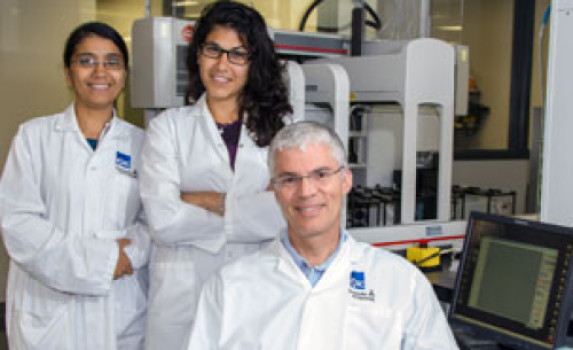
Investigators from the Institute for Research in Immunology and Cancer (IRIC) at the Université de Montréal have just published, in the journal Science, the announcement of the discovery of a new molecule, the first of its kind, which allows for the multiplication of stem cells in a unit of cord blood. Umbilical cord stem cells are used for transplants aimed at curing a number of blood-related diseases, including leukemia, myeloma and lymphoma. For many patients this therapy comprises a treatment of last resort.
Directed by Dr. Guy Sauvageau, principal investigator at IRIC and hematologist at the Maisonneuve-Rosemont Hospital, the research has the potential to multiply by 10 the number of cord blood units available for a transplant in humans. In addition, it will considerably reduce the complications associated with stem cell transplantation. And it will be particularly useful for non-Caucasian patients for whom compatible donors are difficult to identify.
A clinical study using this molecule, named UM171 in honor of the Université de Montréal, and a new type of bioreactor developed for stem culture in collaboration with the University of Toronto will be initiated in December 2014 at the Maisonneuve-Rosemont Hospital.
According to Dr. Guy Sauvageau, “This new molecule, combined with the new bioreactor technology, will allow thousands of patients around the world access to a safer stem cell transplant. Considering that many patients currently cannot benefit from a stem cell transplant for lack of matching donors, this discovery looks to be highly promising for the treatment of various types of cancer.”
The Centre of Excellence for Cellular Therapy at the Maisonneuve-Rosemont Hospital will serve as production unit for these stem cells, and grafts will then be distributed to patients in Montreal, Quebec City and Vancouver for this first Canadian clinical study. Tangible results should be available one year later, that is, in December 2015. The significance of this new discovery is such that over time, conclusive clinical results could revolutionize the treatment of leukemia and other blood-related illnesses.
“These extraordinary advances result from the efforts of a remarkable team that includes extremely gifted students and postdoctoral investigators working in the IRIC laboratories,” adds Dr. Guy Sauvageau. “Among them, the first authors of this publication: Iman Farès, doctoral student, and Jalila Chagraoui, research officer, along with the professionals in IRIC’s medical chemistry core facility under the direction of Anne Marinier, who optimized the therapeutic properties of this new molecule.”
Context
Umbilical cord blood from newborn children is an excellent source of hematopoietic stem cells for stem cell transplants, since their immune system is still immature and the stem cells have a lower probability of inducing an adverse immune reaction in the recipient.
Furthermore, it is not necessary for the immunological compatibility between donor and recipient to be perfect, unlike in a bone marrow transplant. However, in most cases the number of stem cells obtained from an umbilical cord is much too low for treating an adult, and its use is confined above all to the treatment of children. With the new molecule UM171 it will be possible to multiply stem cells in culture and to produce enough of them to treat adults, especially those who are not Caucasian, and who because of the lack of donors have limited access to transplants.
Collaborators from the Maisonneuve-Rosemont Hospital, the British Columbia Cancer Agency, the Ontario Cancer Institute and the Fred Hutchison Cancer Research Center also played an important role in evaluating the biological properties of this new molecule, and those from the University of Toronto in developing the bioreactor.
This study is financed by Canada’s Stem Cell Network; by IRICoR, IRIC’s commercialization organization; by the Réseau de thérapie cellulaire et tissulaire (TheCell) funded by the Fonds de recherche du Québec — Santé; and by the National Institutes of Health.
Story Source:
The above story is based on materials provided by Universite de Montreal. Note: Materials may be edited for content and length.
Journal Reference:
- I. Fares, J. Chagraoui, Y. Gareau, S. Gingras, R. Ruel, N. Mayotte, E. Csaszar, D. J. H. F. Knapp, P. Miller, M. Ngom, S. Imren, D.-C. Roy, K. L. Watts, H.-P. Kiem, R. Herrington, N. N. Iscove, R. K. Humphries, C. J. Eaves, S. Cohen, A. Marinier, P. W. Zandstra, G. Sauvageau. Pyrimidoindole derivatives are agonists of human hematopoietic stem cell self-renewal. Science, 2014; 345 (6203): 1509 DOI: 10.1126/science.1256337
